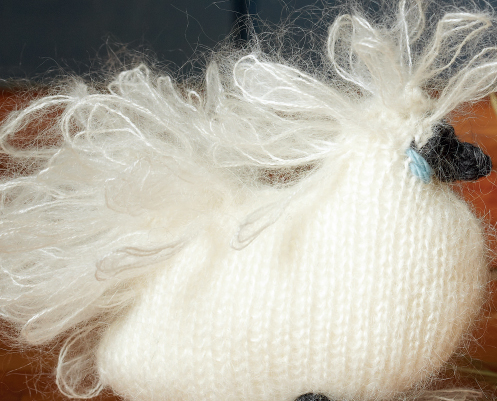

Eccentric-looking, fluffy silkies make excellent pets for children and can be hand-fed. They are natural nurturers and are great broody mothers, so don’t expect many eggs. It is thought that the silkie originated in China. Marco Polo wrote about them as early as the 1400s, describing chickens with fur-like feathers. Uniquely, the silkie has black skin. In Southeast Asia they are considered to be a delicacy. Silkies have five claws, but due to insurmountable technical difficulties, ours has only three.
Fluffy and adorable, the silkie is an unusual bird.
Length: 10cm (4in)
Height to top of head: 9cm (3½in)
• Pair of 2¾mm (US 2) knitting needles
• Double-pointed 2¾mm (US 2) knitting needles (for holding stitches)
• 15g (½oz) of Rowan Kidsilk Haze in Cream 634 (cr) used DOUBLE throughout
• 5g (⅛oz) of Rowan Pure Wool 4ply in Black 404 (bl)
• Tiny amount of Rowan Pure Wool 4ply in Eau de Nil 450 (ea) for eyes
• 2 pipecleaners for legs
• 2 tiny black beads for eyes and sewing needle and black thread for sewing on
See here.
See for Loopy Stitch. Work 2-finger loopy stitch throughout pattern.
See for Wrap and Turn Method.
See for Leg and Claw Method.
With cr, cast on 10 sts.
Beg with a k row, work 2 rows st st.
Row 3: Inc, k9, cast on 3 sts. (14 sts)
Row 4: Inc, p12, inc. (16 sts)
Row 5: Inc, k15, cast on 2 sts. (19 sts)
Row 6: Inc, p17, inc. (21 sts)
Row 7: Inc, k20. (22 sts)
Row 8: Purl.
Row 9: Inc, k21. (23 sts)
Row 10: Purl.
Row 11: Inc, k20, k2tog. (23 sts)
Row 12: P2tog, p21. (22 sts)
Row 13: Inc, k19, k2tog. (22 sts)
Row 14: Purl.
Row 15: K20, loopy st 1, inc. (23 sts)
Row 16: Purl.
Row 17: Inc, k18, loopy st 1, k1, loopy st 1, k1. (24 sts)
Row 18: Purl.
Row 19: K19, loopy st 1, k1, loopy st 1, k1, inc. (25 sts)
Row 20: Purl.
Row 21: Inc, k17, loopy st 1, k1, loopy st 1, k1, loopy st 1, k2. (26 sts)
Row 22: Purl.
Row 23: K2tog, k16, [loopy st 1, k1] 4 times. (25 sts)
Row 24: Purl.
Row 25: K2tog, k14, [loopy st 1, k1] 4 times, k1. (24 sts)
Row 26: P7, cast (bind) off 3 sts, p12 icos, p2tog (hold 13 sts on spare needle for Neck and Head).
Row 27: Rejoin yarn to rem 7 sts for tail, [k1, loopy st 1] 3 times, inc. (8 sts)
Row 28: Inc, p5, p2tog. (8 sts)
Row 29: Cast (bind) off 2 sts, k1 icos, loopy st 1, k1, loopy st 1, k2. (6 sts)
Cast (bind) off.
With cr, cast on 10 sts.
Beg with a p row, work 2 rows st st.
Row 3: Inc, p9, cast on 3 sts. (14 sts)
Row 4: Inc, k12, inc. (16 sts)
Row 5: Inc, p15, cast on 2 sts. (19 sts)
Row 6: Inc, k17, inc. (21 sts)
Row 7: Inc, p20. (22 sts)
Row 8: Knit.
Row 9: Inc, p21. (23 sts)
Row 10: Knit.
Row 11: Inc, p20, p2tog. (23 sts)
Row 13: Inc, p19, p2tog. (22 sts)
Row 14: Knit.
Row 15: Purl.
Row 16: Inc, loopy st 1, k20. (23 sts)
Row 17: Purl.
Row 18: K1, loopy st 1, k1, loopy st 1, k18, inc. (24 sts)
Row 19: Purl.
Row 20: Inc, k1, loopy st 1, k1, loopy st 1, k19. (25 sts)
Row 21: Purl.
Row 22: K2, loopy st 1, k1, loopy st 1, k1, loopy st 1, k17, inc. (26 sts)
Row 23: Purl.
Row 24: [K1, loopy st 1] 4 times, k16, k2tog. (25 sts)
Row 25: P23, p2tog. (24 sts)
Row 26: [K1, loopy st 1] 3 times, k1, cast (bind) off 3 sts, k12 icos, k2tog (hold 13 sts on spare needle for Neck and Head).
Row 27: Rejoin yarn to rem 7 sts for tail, p6, inc. (8 sts)
Row 28: Inc, [loopy st 1, k1] twice, loopy st 1, k2tog. (8 sts)
Row 29: Cast (bind) off 2 sts, p to end. (6 sts)
Cast (bind) off.

Body
This is a delicate bird so it only needs light stuffing.
Row 1: With cr and RS facing, k13 from spare needle of Right Side of Body then k13 from spare needle of Left Side of Body. (26 sts)
Row 2: P2tog, p9, [p2tog] twice, p9, p2tog. (22 sts)
Row 3: K2tog, k18, k2tog. (20 sts)
Row 4: P2tog, p6, [p2tog] twice, p6, p2tog. (16 sts)
Join in bl.
Row 5: Cast on 3 sts bl, k2bl, k3cr, loopy st 1cr, [k2togcr] twice, loopy st 1cr, k3cr, k2bl, cast on 3 sts bl. (20 sts)
Row 6: Cast (bind) off 2 sts bl, p4bl icos, p8cr, p6bl. (18 sts)
Row 7: Cast (bind) off 2 sts bl, k5bl, [k1cr, loopy st 1cr] 3 times, w&t (leave 5 sts on lefthand needle unworked).
Row 8: Working top of head on centre 6 sts only, p6cr, w&t.
Row 9: [K1cr, loopy st 1cr] 3 times, w&t.
Row 10: P6cr, w&t.
Row 11: [Loopy st 1cr, k1] 3 times, k2cr, k3bl. (16 sts in total)
Row 12: P2togbl, p1bl, p3cr, [p2togcr] twice, p3cr, p1bl, p2togbl. (12 sts)
Row 13: K2togbl, [k1cr, loopy st 1cr] 4 times, k2togbl. (10 sts)
Cont in cr.
Row 14: P2tog, p1, [p2tog] twice, p1, p2tog. (6 sts)
Cast (bind) off.
(make 2 the same)
With bl, cast on 5 sts.
Beg with a k row, work 4 rows st st. Join in cr.
Row 5: Loopy st 5cr.
Cont in bl.
Work 9 rows st st.
Cast (bind) off.
(make 2 the same)
With bl, cast on 5 sts.
Beg with a k row, work 11 rows st st.
Cast (bind) off.
SEWING IN ENDS Sew in ends, leaving ends from cast on and cast (bound) off rows for sewing up.
BODY With WS together and whip stitch, sew around the body, leaving a 2.5cm (1in) gap.
STUFFING Stuff the silkie firmly (but do not stuff the beak), then sew up the gap. Mould body into shape.
LEGS AND FEET Using a 20cm (8in) length of pipecleaner and the Leg and Claw Method (see here), make up legs and feet. The silkie’s legs are 2cm (¾in) high. To attach the legs, push protruding ends of pipecleaners into base of body approx 4 rows apart.
EYES Sew black beads a little behind the beak. With ea, sew 2 slanting satin stitches on edge of black section of head.